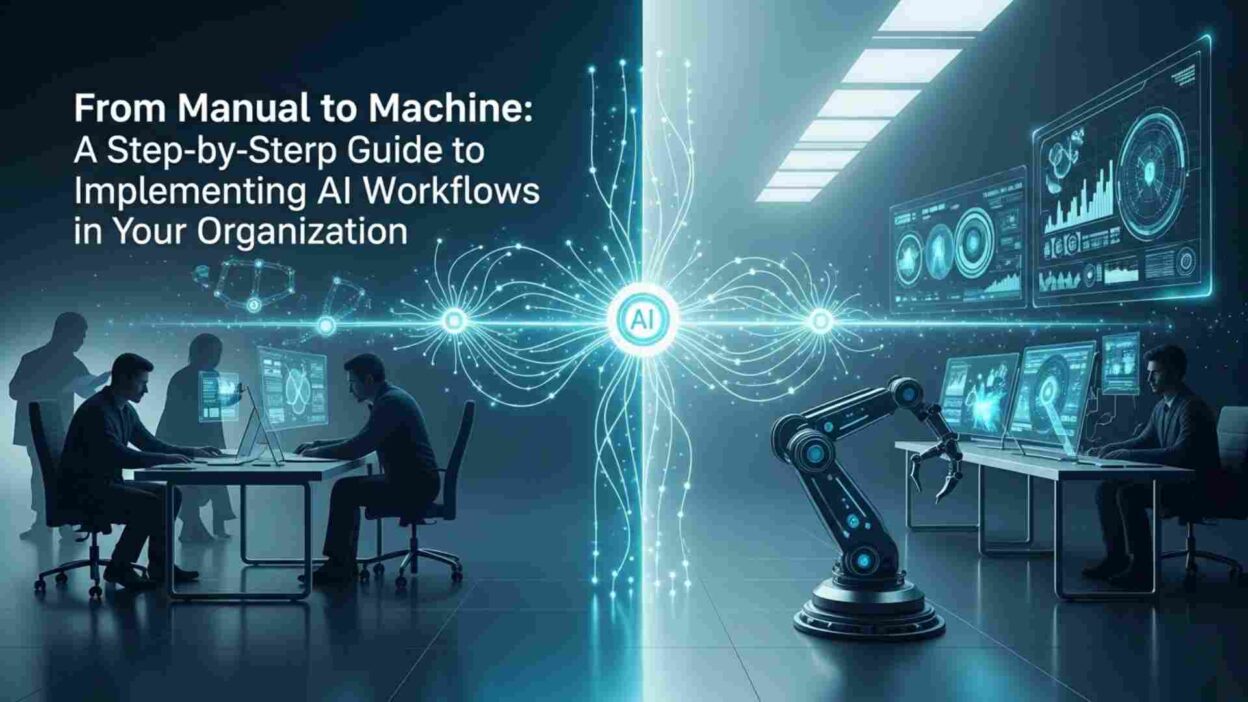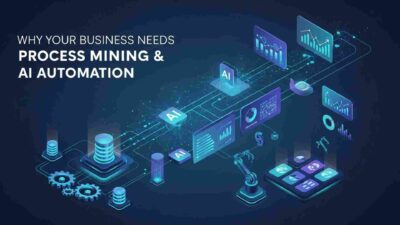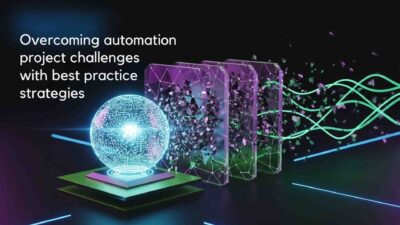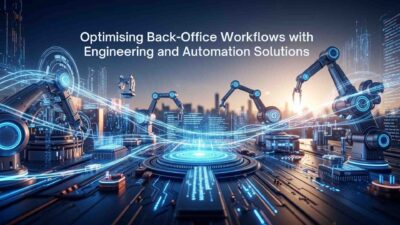Introduction
TL;DR Organizations worldwide struggle with outdated manual processes. Employees spend countless hours on repetitive tasks that drain productivity. Error rates climb as human fatigue sets in during monotonous work.
The shift toward intelligent automation represents more than technological upgrade. Transitioning from manual processes to AI automation fundamentally changes how companies operate and compete. Early adopters report efficiency gains exceeding 60% in transformed workflows.
Your organization likely maintains dozens of processes ripe for automation. Document processing consumes entire departments. Data entry errors ripple through systems causing expensive corrections. Customer inquiries wait hours for responses that machines could deliver instantly.
This comprehensive guide walks you through each implementation phase. You’ll discover practical strategies for identifying automation opportunities. Real-world examples illuminate common pitfalls and proven solutions. Step-by-step frameworks remove the guesswork from your transformation journey.
Table of Contents
Understanding the Current Manual Process Landscape
Recognizing the True Cost of Manual Work
Manual processes hide their actual expense beneath surface-level observations. Direct labor costs represent only the beginning of true expenditure. Factor in error correction, rework, and delayed decision-making.
Employees performing repetitive tasks experience lower job satisfaction. Turnover rates spike in departments handling mundane workflows. Recruitment and training costs multiply as positions churn regularly.
Opportunity costs dwarf these visible expenses. Strategic initiatives stall while teams manage operational tasks. Innovation suffers when creative minds spend time on data entry. Competitive advantages slip away to more agile rivals.
Inconsistency plagues manual workflows across locations and shifts. Each employee develops personal shortcuts and workarounds. Quality varies wildly depending on who handles each transaction. Customers receive different experiences based on random assignment.
Identifying Bottlenecks and Pain Points
Process mapping reveals where workflows bog down most severely. Document every step from initiation through completion. Time each activity to understand actual duration versus perception.
Handoffs between departments create natural friction points. Information gets lost or distorted during transfers. Approval queues stack up as managers juggle competing priorities. Customers wait while internal coordination happens behind scenes.
Data silos force employees to toggle between multiple systems. Manual re-entry introduces errors and wastes precious time. Reconciliation activities consume hours verifying information consistency. Reports require extensive compilation from disparate sources.
Peak demand periods expose capacity limitations dramatically. Backlogs grow while teams work overtime attempting to catch up. Service levels deteriorate precisely when customer expectations run highest. Scalability remains impossible without proportional headcount increases.
Assessing Organizational Readiness
Leadership commitment determines transformation success more than any technical factor. Executives must understand the strategic imperative and long-term benefits. Budget allocation requires multi-year perspective rather than quarterly thinking.
Transitioning from manual processes to AI automation demands cultural shifts alongside technological changes. Employees need reassurance about their evolving roles. Change management resources must receive adequate investment and priority.
Technical infrastructure readiness varies significantly across organizations. Legacy systems may lack integration capabilities required for automation. Data quality issues surface once machines attempt to process information. Security protocols need updating for new access patterns.
Skill gaps exist in most organizations approaching AI implementation. Few companies maintain in-house expertise across relevant technologies. Training programs take months to develop internal capabilities. Partnership strategies help bridge knowledge deficiencies during early phases.
Conducting a Comprehensive Process Audit
Documenting Current State Workflows
Complete documentation forms the foundation for successful automation initiatives. Capture every process step with precise detail and timing. Include exception handling and edge cases often overlooked.
Shadowing employees reveals undocumented workarounds and informal procedures. Workers develop coping mechanisms for system limitations over years. These adaptations rarely appear in official process documentation. Understanding actual practices prevents automation failures from idealized assumptions.
Input and output requirements need explicit specification for each workflow. Define data formats, quality standards, and validation rules. Identify decision points and the criteria driving each choice. Document escalation paths when standard procedures prove insufficient.
Compliance requirements constrain automation design in regulated industries. Map regulatory touchpoints throughout existing workflows. Identify audit trail requirements and data retention policies. Security protocols govern information access and handling procedures.
Measuring Baseline Performance Metrics
Quantifying current performance establishes benchmarks for improvement measurement. Track cycle times from process initiation through final completion. Calculate error rates across different workflow stages and categories.
Volume metrics reveal capacity constraints and scalability challenges. Count transactions processed hourly, daily, and monthly. Identify seasonal patterns affecting demand fluctuations. Analyze distribution across different transaction types.
Cost accounting allocates expenses accurately to specific processes. Include direct labor costs and fully loaded overhead allocations. Factor in technology expenses for systems supporting workflows. Calculate quality costs from errors, rework, and customer dissatisfaction.
Customer impact metrics connect operational performance to business outcomes. Measure response times, resolution rates, and satisfaction scores. Track Net Promoter Scores and customer effort indices. Correlate operational metrics with retention and revenue patterns.
Prioritizing Automation Opportunities
Not every manual process deserves immediate automation investment. Apply systematic criteria to rank opportunities objectively. Volume and frequency drive return on investment calculations significantly.
Rule-based processes with clear decision logic automate most successfully. Standardized inputs and outputs simplify technical implementation. Low exception rates reduce complexity and edge case handling.
Transitioning from manual processes to AI automation delivers fastest returns where manual work proves most painful. Target workflows generating frequent employee complaints. Focus on bottlenecks constraining broader organizational performance. Address areas where errors create serious downstream consequences.
Strategic importance elevates certain processes despite modest efficiency gains. Customer-facing workflows impact experience and competitive positioning. Revenue-generating activities justify investment through top-line growth. Compliance-critical processes reduce risk exposure and regulatory penalties.
Building Your AI Automation Strategy
Defining Clear Objectives and Success Metrics
Vague goals doom automation initiatives to scope creep and disappointment. Specify measurable targets for efficiency, quality, and speed improvements. Quantify acceptable implementation timelines and budget constraints.
Financial objectives might include labor cost reduction percentages or ROI thresholds. Operational targets could specify cycle time decreases or throughput increases. Quality goals establish acceptable error rates and customer satisfaction levels.
Organizational objectives extend beyond pure efficiency considerations. Employee satisfaction improvements reduce turnover and recruitment costs. Capacity expansion enables growth without proportional headcount additions. Competitive positioning gains justify investments transcending direct financial returns.
Risk mitigation objectives address compliance and business continuity concerns. Audit trail improvements satisfy regulatory requirements. Consistency gains reduce liability exposure from process variations. Disaster recovery capabilities ensure operations during disruptions.
Selecting the Right AI Technologies
The automation technology landscape spans numerous options with different strengths. Robotic process automation handles screen-based interactions with existing applications. Machine learning models identify patterns and make predictions. Natural language processing interprets unstructured text and speech.
Computer vision extracts information from documents and images automatically. Workflow engines orchestrate complex processes across multiple systems. Decision management platforms codify and execute business rules consistently.
Transitioning from manual processes to AI automation requires matching technologies to specific use cases. Simple repetitive tasks need basic RPA capabilities. Complex decision-making demands advanced machine learning models. Customer interactions benefit from natural language understanding.
Vendor selection balances capabilities against cost and implementation complexity. Cloud platforms offer rapid deployment with minimal infrastructure investment. On-premises solutions provide control for security-sensitive applications. Hybrid approaches combine cloud flexibility with on-premises governance.
Creating a Phased Implementation Roadmap
Attempting comprehensive transformation simultaneously overwhelms organizations and guarantees failure. Break the journey into manageable phases with clear milestones. Sequence projects to build capabilities progressively over time.
Quick wins in early phases build momentum and organizational confidence. Target high-visibility processes delivering measurable benefits rapidly. Success stories convert skeptics into automation advocates. Learning from initial projects informs subsequent implementations.
Foundation-building activities enable later automation initiatives. Data quality improvements benefit multiple downstream projects. Integration platforms connect systems once for many workflows. Governance frameworks guide consistent decision-making across initiatives.
Long-term phases tackle complex processes requiring advanced capabilities. Dependencies on earlier phases dictate sequencing constraints. Resource availability influences realistic timeline expectations. Market dynamics may accelerate or delay specific initiatives.
Preparing Your Data and Infrastructure
Assessing and Improving Data Quality
AI systems depend absolutely on clean, accurate data inputs. Garbage in guarantees garbage out regardless of algorithm sophistication. Data quality assessment reveals gaps requiring remediation before automation.
Completeness checks identify missing values and incomplete records. Accuracy validation compares data against authoritative sources. Consistency analysis finds contradictions across related data elements. Timeliness review flags outdated information requiring refresh.
Data cleansing projects correct identified deficiencies systematically. Automated validation rules prevent future quality degradation. Master data management creates single sources of truth. Ongoing monitoring maintains quality standards over time.
Transitioning from manual processes to AI automation exposes data problems hidden in manual workflows. Humans intuitively handle inconsistencies that confuse machines. Workers compensate for missing information through experience and judgment. Automation requires explicit handling for every edge case.
Building Integration Capabilities
Modern enterprises run dozens or hundreds of software applications. Automation workflows must access and update information across systems. Integration architecture determines project feasibility and complexity.
API-first approaches provide standardized access to application functionality. RESTful interfaces enable loosely coupled connections between systems. Middleware platforms translate between incompatible data formats. Enterprise service buses orchestrate complex interaction patterns.
Real-time integration enables immediate processing and response. Batch processing handles high-volume updates during off-peak hours. Hybrid approaches balance responsiveness against system load. Error handling and retry logic ensure reliability.
Security controls govern access to sensitive systems and data. Authentication mechanisms verify identity of automated processes. Authorization rules enforce least-privilege access principles. Encryption protects data in transit and at rest.
Establishing Governance Frameworks
Automation proliferation without governance creates chaos and risk. Define standards for development approaches and tool selection. Specify approval processes for new automation initiatives. Establish monitoring and compliance verification procedures.
Centers of excellence provide expertise and best practice guidance. Reusable components accelerate development and ensure consistency. Training programs build organizational capabilities systematically. Community forums facilitate knowledge sharing across teams.
Change management protocols control modifications to production automations. Version control tracks changes and enables rollback capability. Testing requirements verify functionality before deployment. Documentation standards maintain knowledge for future maintenance.
Risk management frameworks identify and mitigate potential failure modes. Business continuity planning ensures alternatives when automation fails. Disaster recovery procedures restore capabilities after disruptions. Insurance strategies transfer residual risks to external parties.
Designing and Developing AI Workflows
Mapping Automated Process Flows
Automated workflows often differ from manual process equivalents significantly. Remove steps that exist solely due to human limitations. Eliminate handoffs between people that machines handle in single operations. Compress sequential activities into parallel execution where dependencies allow.
Exception handling requires explicit design in automated workflows. Define conditions triggering each exception scenario. Specify automated resolution approaches where possible. Establish escalation paths to human decision-makers when necessary.
Transitioning from manual processes to AI automation creates opportunities for process improvement beyond simple digitization. Challenge assumptions embedded in legacy workflows. Redesign end-to-end processes rather than automating broken procedures. Leverage machine capabilities impossible in manual operations.
User interface requirements simplify dramatically in automated workflows. Machines read data directly rather than through screens. Human touchpoints need intuitive interfaces for oversight and intervention. Mobile access enables monitoring and approval from anywhere.
Developing and Training AI Models
Machine learning models require training data representing real-world scenarios. Historical records provide training examples for supervised learning. Labeled data teaches models to recognize patterns and outcomes. Adequate volume ensures models handle edge cases effectively.
Feature engineering transforms raw data into model inputs. Domain expertise identifies relevant predictive factors. Statistical analysis validates feature importance and correlation. Dimensionality reduction improves performance and interpretability.
Model training iterates through multiple algorithm approaches. Compare performance across different model architectures. Tune hyperparameters optimizing accuracy and efficiency. Cross-validation prevents overfitting to training data.
Testing validates model performance on unseen data. Accuracy metrics measure prediction correctness. Precision and recall balance different error types. Confusion matrices reveal specific failure patterns requiring attention.
Building User Interfaces and Controls
Human oversight remains essential even in highly automated workflows. Dashboards provide visibility into automation performance and status. Alert mechanisms notify staff of exceptions requiring attention. Approval interfaces enable human authorization for sensitive decisions.
Design principles emphasize clarity and efficiency for occasional users. Intuitive layouts minimize training requirements. Contextual help guides users through infrequent scenarios. Mobile responsiveness enables access from any device.
Audit trails capture every automated action and human intervention. Timestamps record when events occur precisely. User attribution tracks who performed each manual action. Immutable logs prevent tampering with historical records.
Configuration interfaces allow business users to adjust automation behavior. Rule editors enable non-technical staff to modify decision logic. Threshold adjustments accommodate changing business requirements. Template management maintains consistency while enabling customization.
Testing and Quality Assurance
Conducting Comprehensive Testing
Thorough testing prevents catastrophic failures after production deployment. Unit testing validates individual component functionality. Integration testing verifies system interactions work correctly. End-to-end testing confirms complete workflow execution.
Test data must cover normal scenarios and edge cases comprehensively. Include boundary conditions and extreme values. Simulate error conditions and system failures. Verify graceful degradation when dependencies become unavailable.
Transitioning from manual processes to AI automation requires new testing approaches. Machine learning models need testing across diverse data distributions. Adversarial testing probes for unexpected model behaviors. Bias detection ensures fair treatment across demographic groups.
Performance testing validates system responsiveness under load. Stress testing identifies breaking points and capacity limits. Soak testing reveals memory leaks and gradual degradation. Chaos engineering verifies resilience through deliberate failure injection.
Implementing Quality Control Measures
Continuous monitoring catches issues before they impact operations significantly. Real-time dashboards display key performance indicators. Automated alerts trigger when metrics exceed thresholds. Trend analysis identifies gradual degradation over time.
Quality metrics track accuracy, completeness, and timeliness. Error rates measure how often automation produces incorrect results. Exception rates indicate unusual conditions requiring human review. Processing times reveal performance degradation.
Sampling strategies verify automation accuracy without checking every transaction. Random sampling catches systematic errors effectively. Risk-based sampling focuses scrutiny on high-value transactions. Statistical process control identifies when quality drifts outside acceptable ranges.
Feedback loops enable continuous improvement of automated workflows. User reports surface issues not caught by automated monitoring. Root cause analysis prevents recurring problems. Model retraining incorporates new data and scenarios.
Planning Rollback and Contingency Procedures
Automation failures will occur despite careful planning and testing. Rollback capabilities restore manual operations quickly when needed. Runbooks document step-by-step recovery procedures. Regular drills ensure staff maintain response capabilities.
Gradual rollout strategies limit blast radius from unforeseen issues. Pilot groups test automation with real work before broad deployment. Percentage-based rollouts incrementally increase automated volume. Geographic or departmental phasing contains potential problems.
Parallel running maintains manual processes during initial automation deployment. Compare automated and manual results for validation. Human review catches discrepancies before downstream impacts. Confidence builds before cutting over completely.
Change Management and Training
Communicating the Vision and Benefits
Employee support determines automation success as much as technical execution. Clear communication explains why change happens now. Honest discussion addresses concerns about job security. Transparent roadmaps help people prepare for evolving roles.
Transitioning from manual processes to AI automation creates anxiety among affected workers. Frame automation as augmentation rather than replacement. Emphasize how technology eliminates tedious work. Highlight opportunities for skill development and career growth.
Success stories from other organizations provide relatable examples. Case studies demonstrate tangible benefits for employees. Testimonials from peers carry more weight than executive pronouncements. Site visits allow teams to see automation in action.
Regular updates maintain awareness throughout lengthy implementations. Town halls provide forums for questions and concerns. Email newsletters share progress and milestones. Intranet sites offer self-service information access.
Developing Training Programs
Comprehensive training prepares employees for new ways of working. Role-based curricula address different learning needs across the organization. Executives need strategic understanding without technical depth. Managers require operational knowledge for supervision and troubleshooting.
End users need hands-on practice with new interfaces and procedures. Simulated environments enable risk-free learning. Progressive scenarios build confidence through graduated complexity. Certification programs validate competency before production access.
Ongoing education addresses evolving capabilities and procedures. Refresher training reinforces key concepts over time. Advanced courses develop power users and super users. Documentation provides reference materials for infrequent tasks.
Support structures help employees during the learning curve. Help desks answer questions during daily work. Champions within teams provide peer assistance. Office hours with automation team build relationships.
Managing Organizational Change
Cultural transformation accompanies technological implementation. Leadership must model desired behaviors and attitudes. Recognition programs celebrate adoption and innovation. Performance metrics align with automation objectives.
Resistance manifests in various forms requiring different responses. Active opposition needs direct engagement and listening. Passive resistance may indicate insufficient communication or training. Silent skepticism surfaces through adoption metrics and feedback.
Change agents throughout the organization accelerate adoption. Early adopters demonstrate benefits to peer groups. Influencers sway opinion through informal networks. Success stories spread organically through storytelling.
Deployment and Optimization
Executing Production Rollout
Production deployment represents culmination of months of preparation and work. Detailed cutover plans specify every activity and responsibility. Communication ensures all stakeholders understand timing and expectations. Backup resources stand ready for unexpected issues.
Deployment windows minimize disruption to business operations. Weekend or overnight implementations avoid peak periods. Phased approaches roll out incrementally across locations or departments. Pilot deployments validate approaches before broader rollout.
Transitioning from manual processes to AI automation requires meticulous coordination across multiple teams. Technical staff handle system configurations and data migrations. Business teams verify operational readiness. Support organizations prepare for potential issues.
Go-live support provides extra resources during critical initial periods. War rooms facilitate rapid issue resolution. Extended hours coverage handles problems outside normal business times. Daily standups maintain visibility and coordination.
Monitoring Performance and Usage
Comprehensive monitoring tracks both technical and business metrics. System health indicators measure uptime and responsiveness. Transaction volumes confirm expected usage patterns. Error rates reveal quality issues requiring attention.
Business outcomes demonstrate value realization from automation investments. Efficiency gains appear through reduced processing times. Cost savings materialize from decreased manual effort. Quality improvements show in lower error rates.
User adoption metrics indicate whether staff embrace new capabilities. Login frequency suggests engagement levels. Feature utilization reveals which capabilities add value. Support ticket volume indicates training effectiveness.
Comparative analysis measures actual results against original projections. Variance analysis identifies gaps between expected and achieved benefits. Root cause investigation determines reasons for shortfalls. Corrective actions close gaps over time.
Driving Continuous Improvement
Initial deployment represents beginning rather than completion of automation journey. Performance data reveals optimization opportunities. User feedback highlights pain points and enhancement requests. Technology evolution enables new capabilities.
A/B testing validates improvement hypotheses before full implementation. Controlled experiments isolate impacts of specific changes. Statistical analysis determines significant differences. Winning variations roll out to all users.
Model retraining incorporates new data and scenarios regularly. Drift detection identifies when performance degrades. Automated retraining pipelines maintain model currency. Version control enables rollback if retraining degrades performance.
Process mining analyzes actual workflow execution patterns. Visualization reveals bottlenecks and inefficiencies. Conformance checking identifies deviations from designed processes. Insights drive targeted improvement initiatives.
Measuring Success and ROI
Calculating Financial Returns
Hard dollar savings quantify direct cost reductions from automation. Labor savings calculate hours eliminated multiplied by loaded rates. Error reduction benefits estimate costs of mistakes prevented. Speed improvements translate to capacity expansion without headcount growth.
Soft benefits prove harder to quantify but create real value. Customer satisfaction improvements reduce churn and increase lifetime value. Employee satisfaction gains decrease turnover and recruitment costs. Risk reduction prevents potentially catastrophic compliance failures.
Transitioning from manual processes to AI automation generates returns across multiple dimensions. Revenue growth stems from faster customer response and improved conversion. Market share gains result from competitive advantages. Premium pricing becomes possible through superior service delivery.
Total cost of ownership includes implementation and ongoing expenses. Initial costs cover software licenses, integration, and training. Operating costs include maintenance, support, and infrastructure. Hidden costs emerge from change management and process redesign.
Tracking Key Performance Indicators
Balanced scorecards provide comprehensive performance visibility. Financial metrics measure cost and revenue impacts. Operational metrics track efficiency and quality. Customer metrics gauge experience and satisfaction. Employee metrics assess engagement and capability.
Leading indicators predict future performance trends. Pipeline metrics forecast upcoming transaction volumes. Training completion rates suggest readiness for changes. System adoption rates indicate future productivity gains.
Lagging indicators confirm actual achieved results. Processing times demonstrate efficiency improvements. Error rates prove quality enhancements. Customer satisfaction scores reflect experience changes.
Benchmarking compares performance against relevant standards. Industry averages provide context for results. Best-in-class targets stretch organizational ambitions. Historical baselines show improvement trajectories.
Communicating Results to Stakeholders
Executive audiences need concise summaries highlighting strategic impacts. Dashboard views show key metrics at a glance. Exception reporting focuses attention on issues requiring decisions. Trend analysis reveals long-term patterns.
Operational teams require detailed metrics for daily management. Real-time dashboards enable quick response to emerging issues. Drill-down capabilities support root cause investigation. Custom views focus on relevant responsibilities.
External stakeholders including customers and partners need appropriate information. Service level achievement demonstrates commitment fulfillment. Performance improvements justify premium pricing or renewed contracts. Innovation capabilities attract new business partnerships.
Read more:-How to Identify & Prioritise Automation Opportunities in Your Business
Conclusion

Transitioning from manual processes to AI automation represents one of the most significant business transformations available today. Organizations embracing this journey gain competitive advantages that compound over time. Those delaying face mounting disadvantages against more efficient rivals.
The seven-step framework outlined here provides a proven path forward. Start with comprehensive process audits identifying best opportunities. Build strategic foundations through planning and preparation. Execute methodically with strong change management support.
Success requires commitment across the organization from executives to frontline employees. Technology alone never drives transformation without human engagement. Cultural shifts prove as important as technical implementations.
Quick wins in early phases build momentum for longer-term initiatives. Celebrate successes to maintain organizational enthusiasm. Learn from setbacks to improve future implementations. Persist through inevitable challenges with clear vision of destination.
Transitioning from manual processes to AI automation liberates human potential for higher-value work. Employees escape tedious repetitive tasks that drain motivation. Teams redirect energy toward innovation and strategic initiatives. Organizations become more agile and responsive to market changes.
The journey never truly ends as technology continues evolving rapidly. New capabilities emerge regularly expanding automation possibilities. Continuous improvement mindsets maximize ongoing value realization. Organizations develop sustainable competitive advantages through automation excellence.
Your competitors already understand these realities and act accordingly. Market leaders invest heavily in automation capabilities. Laggards struggle to catch up while falling further behind. The question isn’t whether to automate but how quickly you can move.
Begin your Transitioning from manual processes to AI automation journey today with clear first steps. Conduct process audits revealing highest-impact opportunities. Build stakeholder coalitions supporting transformation. Select pilot projects delivering quick wins and valuable learning.
Resources and expertise exist to support your efforts throughout the journey. Technology vendors provide platforms and implementation services. Consultants offer specialized knowledge and experience. Industry groups facilitate peer learning and best practice sharing.
The future belongs to organizations that effectively blend human creativity with machine efficiency. Your team possesses unique domain knowledge and customer relationships. AI automation amplifies these strengths rather than replacing them. The combination creates unbeatable competitive positioning.
Take action now rather than waiting for perfect conditions. Perfect clarity never emerges before starting the journey. Learning happens through doing rather than endless planning. Early movers capture advantages while others deliberate.
Your organization deserves the efficiency, quality, and satisfaction benefits automation delivers. Employees merit liberation from soul-crushing repetitive work. Customers expect responsive service only automation enables at scale. Shareholders require competitive returns automation helps generate.
The roadmap exists, the technology works, and the benefits justify the effort. Everything needed for success lies within reach of committed organizations. Transitioning from manual processes to AI automation starts with a single decision and first step. Make that choice today and transform your organization’s future.





